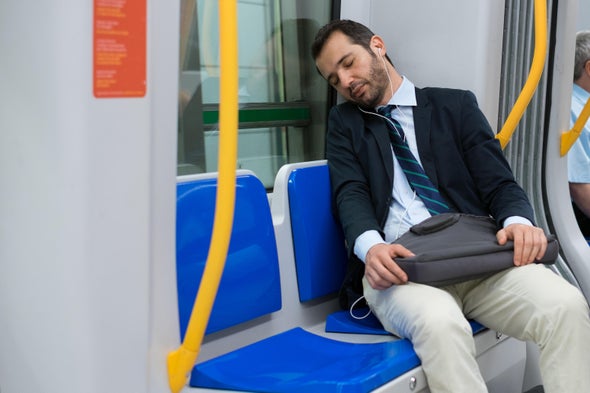(单词翻译:单击)
听力文本
This is Scientific American — 60-Second Science. I'm Karen Hopkin.
Every new parent knows, or learns pretty quickly, that rocking can calm that fussy baby when it's time to take a nap. But the benefits of gentle motion may extend past the swaddling stage. Because two new studies show that rocking also helps grown-ups, both human and mouse, get a good night's sleep. The two research efforts are in the journal Current Biology.
What should be no surprise is that movement can be soothing. Think of how many times you've fallen asleep on a train. But can motion really induce a doze, and make for a deeper sleep? To find out, researchers invited 18 healthy volunteers for a sleepover.
"So they came to the lab and they slept one time on the stationary position, normal bed. And one night where they got rocked."
Aurore Perrault, a sleep researcher at the University of Geneva in Switzerland.
"And what we find is actually compared to a stationary night, a whole night of rocking sleep has a beneficial impact. Not only on sleep initiation, which means they fall asleep faster, but also on sleep maintenance, as we saw that they have less micro-awakening during the night."
Subjects who rocked also did better on a memory test the next morning than did the stiller sleepers.

In the second study, Konstantinos Kompotis, a postdoctoral fellow at the University of Lausanne, rocked a rack of rodents.
"Whether rocking affects sleep in species other human was never before discussed. So the main questions for our study were does rocking affect sleep in mice and what is the underlying mechanism?"
Kompotis placed the mouse cages on a platform that moved from side to side. And though mice were rocked four times faster than their human counterparts—a frequency of one back-and-forth per second, or 1 Hertz, worked best—the results were strikingly similar.
"During rocking at 1 Hertz, time spent asleep increased, there were more transitions from wakefulness to non-REM sleep, and mice fell asleep twice as fast than at stationary condition."
The effect required an ability to detect motion. Mice with a defective vestibular system, which is key to maintaining balance, did not become lulled by the sleep-inducing platform.
Additional studies could allow the researchers to identify a new target for treating sleep disorders, including insomnia. Until then, you might think about adding a little swing to your nighttime routine.
Thanks for listening for Scientific American — 60-Second Science. I'm Karen Hopkin.
参考译文
这里是科学美国人——60秒科学。我是凯伦·霍普金。
每位初为父母的人都知道或很快就能学会,摇晃可以让哭闹的宝宝在该睡觉的时候安静下来。但轻柔摇晃的益处可能会超越襁褓阶段。因为两项新研究表明,摇晃也能帮助成年人,可让成年人或成年老鼠一夜好眠。这两项研究成果发表在《当代生物学》期刊上。
摇晃有安抚作用,这应该不足为奇。想想你有多少次在火车上睡着。但晃动真的能让人打瞌睡、继而陷入更深层睡眠吗?为了寻找答案,研究人员邀请18名健康的志愿者过夜。
“他们来到实验室,在固定位置的普通床上睡一次觉。之后再在摇晃中睡一晚。”
瑞士日内瓦大学的睡眠研究员奥洛尔·佩罗特说到。
“我们发现,与静止的夜晚相比,整夜摇晃的睡眠会产生有益影响。不仅对睡眠初始阶段有益,这意味着他们会更快入睡,还对睡眠维持有益,因为我们看到他们在夜晚微醒的次数减少了。”
在第天早上进行的记忆测试中,摇晃睡眠的参与者比相对静止的睡眠者表现更好。
在第二项研究中,洛桑大学的博士后研究员康斯坦丁诺斯·科姆波蒂斯摇晃了一架子老鼠。
“此前从未有人讨论过摇晃是否会影响人类以外的其他物种的睡眠。因此我们研究的主要问题是:摇晃是否会影响老鼠的睡眠以及其中的潜在机制是什么。”
科姆波蒂斯将鼠笼放在来回移动的平台上。尽管老鼠被摇晃的频率是人类的四倍——效果最佳的晃动频率为每秒来回一次或1赫兹——但结果却与人类惊人地相似。
“摇晃频率为1赫兹时,老鼠的睡眠时间增加了,从清醒到非快速眼动睡眠的过渡更长,老鼠入睡速度比静止状态快了两倍。”
这种效果需要察觉移动的能力。前庭系统是维持平衡的关系,而前庭系统有缺陷的老鼠没有被睡眠诱导平台催眠。
进一步研究可以让研究人员确定新目标,治疗失眠等睡眠障碍。在那之前,你或许可以考虑在夜间活动中增加点摇摆元素。
谢谢大家收听科学美国人——60秒科学。我是凯伦·霍普金。
译文为可可英语翻译,未经授权请勿转载!
重点讲解
重点讲解:
1. think of 想到;想起;想出;
When I said that I wasn't thinking of anyone in particular.
我说那话时,并没有想到任何具体的人。
2. fall asleep 入睡;睡着;进入梦乡;
Sam snuggled down in his pillow and fell asleep.
萨姆舒服地枕着枕头进入了梦乡。
3. make for 导致;有利于;
A happy parent makes for a happy child.
有快乐的父母,才会有快乐的孩子。
4. compared to 与…相比;和…比起来;
Compared to people living only a few generations ago, we have greater opportunities to have a good time.
比起上几辈人,我们有更多机会享受生活。


